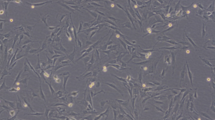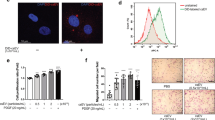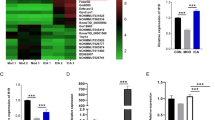Abstract
Aim:
To understand the effects of lithospermic acid (LA), a potent antioxidant from the water-soluble extract of Salvia miltiorrhiza, on the migration and proliferation of rat thoracic aorta vascular smooth muscle cells (VSMCs).
Methods:
VSMC migration, proliferation, DNA synthesis and cell cycle progression were investigated by transwell migration analysis, 3-(4,5-dimethylthiazol-2-yl)-2,5-diphenyltetrazolium bromide (MTT) assay, bromodeoxyuridine (BrdU) incorporation assay, and flow cytometric detection, respectively. Intracellular reactive oxygen species (ROS) generation was detected using 2′,7′-dichlorofluorescin diacetate (DCFH-DA). The expression of cyclin D1 protein and matrix metalloproteinase-9 (MMP-9) protein, as well as the phosphorylation state of ERK1/2, were determined using Western blots. The activity of MMP-9 and the expression of MMP-9 mRNA were assessed by gelatin zymography analysis and RT-PCR, respectively.
Results:
LA (25−100 μmol/L) inhibited both lipopolysaccharide (LPS)- and fetal bovine serum (FBS)-induced ROS generation and ERK1/2 phosphorylation. By down-regulating the expression of cyclin D1 and arresting cell cycle progression at the G1 phase, LA inhibited both VSMC proliferation and DNA synthesis as induced by 5% FBS. Furthermore, LA attenuated LPS-induced VSMC migration by inhibiting MMP-9 expression and its enzymatic activity.
Conclusion:
LA is able to inhibit FBS-induced VSMC proliferation and LPS-induced VSMC migration, which suggests that LA may have therapeutic effects in the prevention of atherosclerosis, restenosis and neointimal hyperplasia.
Similar content being viewed by others
Log in or create a free account to read this content
Gain free access to this article, as well as selected content from this journal and more on nature.com
or
References
Ross R . The pathogenesis of atherosclerosis: a perspective for the 1990s. Nature 1993; 362: 801–9.
Kyaw M, Yoshizumi M, Tsuchiya K, Izawa Y, Kanematsu Y, Tamaki T . Atheroprotective effects of antioxidants through inhibition of mitogen-activated protein kinases. Acta Pharmacol Sin 2004; 25: 977–85.
Lee MY, Griendling KK . Redox signaling, vascular function, and hypertension. Antioxid Redox Signal 2008; 10: 1045–59.
Han MJ, Kim BY, Yoon SO, Chung AS . Cell proliferation induced by reactive oxygen species is mediated via mitogen-activated protein kinase in Chinese hamster lung fibroblast (V79) cells. Mol Cells 2003; 15: 94–101.
Lo IC, Shih JM, Jiang MJ . Reactive oxygen species and ERK 1/2 mediate monocyte chemotactic protein-1-stimulated smooth muscle cell migration. J Biomed Sci 2005; 12: 377–88.
Szocs K, Lassegue B, Sorescu D, Hilenski LL, Valppu L, Couse TL, et al. Upregulation of Nox-based NAD(P)H oxidases in restenosis after carotid injury. Arterioscler Thromb Vasc Biol 2002; 22: 21–7.
Ghigliotti G, Mereto E, Eisenberg PR, Martelli A, Orsi P, Sini D, et al. N-acetyl-cysteine reduces neointimal thickening and procoagulant activity after balloon-induced injury in abdominal aortae of New Zealand white rabbits. Thromb Haemost 2001; 85: 724–9.
Kappert K, Sparwel J, Sandin A, Seiler A, Siebolts U, Leppanen O, et al. Antioxidants relieve phosphatase inhibition and reduce PDGF signaling in cultured VSMCs and in restenosis. Arterioscler Thromb Vasc Biol 2006; 26: 2644–51.
Zhou XM, Lu ZY, Wang DW . Experimental study of Salvia miltiorrhiza on prevention of restenosis after angioplasty. Zhongguo Zhong Xi Yi Jie He Za Zhi 1996; 16: 480–2. Chinese.
Sun B, Yuan Y, Zhang W, Che D . Effects of hypoxic endothelial cell conditioned medium on proliferation and collagen synthesis of smooth muscle cells and inhibitory effects of radix Salviae miltiorrhizae. Chin Med J (Engl) 1995; 108: 855–8.
Du X, Yang F, Wang W, Gong Y . The mechanism of Radix Salviae Miltiorrhizae Injection on the inhibition of smooth muscle cell proliferation induced by H2O2 . Zhong Yao Cai 2003; 26: 647–9. Chinese.
Chen YL, Yang SP, Shiao MS, Chen JW, Lin SJ . Salvia miltiorrhiza inhibits intimal hyperplasia and monocyte chemotactic protein-1 expression after balloon injury in cholesterol-fed rabbits. J Cell Biochem 2001; 83: 484–93.
Wu YJ, Hong CY, Lin SJ, Wu P, Shiao MS . Increase of vitamin E content in LDL and reduction of atherosclerosis in cholesterol-fed rabbits by a water-soluble antioxidant-rich fraction of Salvia miltiorrhiza. Arterioscler Thromb Vasc Biol 1998; 18: 481–6.
Li S, Wan L . Experimental study on the preventive mechanism of Salviae miltiorrhizae against atherosclerosis in rabbits models. J Huazhong Univ Sci Technolog Med Sci 2004; 24: 233–5.
Chen J, Wang F, Lee FS, Wang X, Xie M . Separation and identification of water-soluble salvianolic acids from Salvia miltiorrhiza Bunge by high-speed counter-current chromatography and ESI-MS analysis. Talanta 2006; 69: 172–9.
Liu X, Chen R, Shang Y, Jiao B, Huang C . Lithospermic acid as a novel xanthine oxidase inhibitor has anti-inflammatory and hypouricemic effects in rats. Chem Biol Interact 2008; 176: 137–42.
Wagner H, Horhammer L, Frank U . Lithospermic acid, the antihormonally active principle of Lycopus europaeus L. and Symphytum officinale. 3. Ingredients of medicinal plants with hormonal and antihormonal-like effect. Arzneimittelforschung 1970; 20: 705–13.German.
Zhang ZF, Peng ZG, Gao L, Dong B, Li JR, Li ZY, et al. Three new derivatives of anti-HIV-1 polyphenols isolated from Salvia yunnanensis. J Asian Nat Prod Res 2008; 10: 391–6.
Rodriguez A, Fortuno A, Gomez-Ambrosi J, Zalba G, Diez J, Fruhbeck G . The inhibitory effect of leptin on angiotensin II-induced vasoconstriction in vascular smooth muscle cells is mediated via a nitric oxide-dependent mechanism. Endocrinology 2007; 148: 324–31.
Kim SH, Kang KA, Zhang R, Piao MJ, Ko DO, Wang ZH, et al. Protective effect of esculetin against oxidative stress-induced cell damage via scavenging reactive oxygen species. Acta Pharmacol Sin 2008; 29: 1319–26.
Ishizawa K, Izawa-Ishizawa Y, Ohnishi S, Motobayashi Y, Kawazoe K, Hamano S, et al. Quercetin glucuronide inhibits cell migration and proliferation by platelet-derived growth factor in vascular smooth muscle cells. J Pharmacol Sci 2009; 109: 257–64.
Sasu S, LaVerda D, Qureshi N, Golenbock DT, Beasley D . Chlamydia pneumoniae and chlamydial heat shock protein 60 stimulate proliferation of human vascular smooth muscle cells via toll-like receptor 4 and p44/p42 mitogen-activated protein kinase activation. Circ Res 2001; 89: 244–50.
Gurjar MV, DeLeon J, Sharma RV, Bhalla RC . Mechanism of inhibition of matrix metalloproteinase-9 induction by NO in vascular smooth muscle cells. J Appl Physiol 2001; 91: 1380–6.
Nelson PR, Yamamura S, Mureebe L, Itoh H, Kent KC . Smooth muscle cell migration and proliferation are mediated by distinct phases of activation of the intracellular messenger mitogen-activated protein kinase. J Vasc Surg 1998; 27: 117–25.
Li JM, Brooks G . Cell cycle regulatory molecules (cyclins, cyclin-dependent kinases and cyclin-dependent kinase inhibitors) and the cardiovascular system; potential targets for therapy? Eur Heart J 1999; 20: 406–20.
Pandya HC, Snetkov VA, Twort CH, Ward JP, Hirst SJ . Oxygen regulates mitogen-stimulated proliferation of fetal human airway smooth muscle cells. Am J Physiol Lung Cell Mol Physiol 2002; 283: L1220–30.
Taille C, Almolki A, Benhamed M, Zedda C, Megret J, Berger P, et al. Heme oxygenase inhibits human airway smooth muscle proliferation via a bilirubin-dependent modulation of ERK1/2 phosphorylation. J Biol Chem 2003; 278: 27160–8.
Brar SS, Kennedy TP, Whorton AR, Murphy TM, Chitano P, Hoidal JR . Requirement for reactive oxygen species in serum-induced and platelet-derived growth factor-induced growth of airway smooth muscle. J Biol Chem 1999; 274: 20017–26.
Stoll LL, Denning GM, Weintraub NL . Potential role of endotoxin as a proinflammatory mediator of atherosclerosis. Arterioscler Thromb Vasc Biol 2004; 24: 2227–36.
Lin FY, Chen YH, Tasi JS, Chen JW, Yang TL, Wang HJ, et al. Endotoxin induces toll-like receptor 4 expression in vascular smooth muscle cells via NADPH oxidase activation and mitogen-activated protein kinase signaling pathways. Arterioscler Thromb Vasc Biol 2006; 26: 2630–7.
Torres M . Mitogen-activated protein kinase pathways in redox signaling. Front Biosci 2003; 8: d369–91.
Mehdi MZ, Azar ZM, Srivastava AK . Role of receptor and nonreceptor protein tyrosine kinases in H2O2-induced PKB and ERK1/2 signaling. Cell Biochem Biophys 2007; 47: 1–10.
Peng CY, Pan SL, Huang YW, Guh JH, Chang YL, Teng CM . Baicalein attenuates intimal hyperplasia after rat carotid balloon injury through arresting cell-cycle progression and inhibiting ERK, Akt, and NF-kappaB activity in vascular smooth-muscle cells. Naunyn Schmiedebergs Arch Pharmacol 2008; 378: 579–88.
Burch PM, Heintz NH . Redox regulation of cell-cycle re-entry: cyclin D1 as a primary target for the mitogenic effects of reactive oxygen and nitrogen species. Antioxid Redox Signal 2005; 7: 741–51.
Taupin P . BrdU immunohistochemistry for studying adult neurogenesis: paradigms, pitfalls, limitations, and validation. Brain Res Rev 2007; 53: 198–214.
Nigg EA . Mitotic kinases as regulators of cell division and its checkpoints. Nat Rev Mol Cell Biol 2001; 2: 21–32.
Ross R . Cell biology of atherosclerosis. Annu Rev Physiol 1995; 57: 791–804.
Dollery CM, McEwan JR, Henney AM . Matrix metalloproteinases and cardiovascular disease. Circ Res 1995; 77: 863–8.
Johnson C, Galis ZS . Matrix metalloproteinase-2 and -9 differentially regulate smooth muscle cell migration and cell-mediated collagen organization. Arterioscler Thromb Vasc Biol 2004; 24: 54–60.
Lee WJ, Shin CY, Yoo BK, Ryu JR, Choi EY, Cheong JH, et al. Induction of matrix metalloproteinase-9 (MMP-9) in lipopolysaccharide-stimulated primary astrocytes is mediated by extracellular signal-regulated protein kinase 1/2 (Erk1/2). Glia 2003; 41: 15–24.
Lai WC, Zhou M, Shankavaram U, Peng G, Wahl LM . Differential regulation of lipopolysaccharide-induced monocyte matrix metalloproteinase (MMP)-1 and MMP-9 by p38 and extracellular signal-regulated kinase 1/2 mitogen-activated protein kinases. J Immunol 2003; 170: 6244–9.
Huang C, Jacobson K, Schaller MD . MAP kinases and cell migration. J Cell Sci 2004; 117: 4619–28.
Acknowledgements
This work was supported by National Basic Research Program of China (No 2009CB930300)
Author information
Authors and Affiliations
Corresponding author
Rights and permissions
About this article
Cite this article
Chen, L., Wang, Wy. & Wang, Yp. Inhibitory effects of lithospermic acid on proliferation and migration of rat vascular smooth muscle cells. Acta Pharmacol Sin 30, 1245–1252 (2009). https://doi.org/10.1038/aps.2009.122
Received:
Accepted:
Published:
Issue date:
DOI: https://doi.org/10.1038/aps.2009.122
Keywords
This article is cited by
-
Lipopolysaccharide acting via toll-like receptor 4 transactivates the TGF-β receptor in vascular smooth muscle cells
Cellular and Molecular Life Sciences (2022)
-
Applications of Knoevenagel condensation reaction in the total synthesis of natural products
Monatshefte für Chemie - Chemical Monthly (2020)
-
Salvia miltiorrhizaBurge (Danshen): a golden herbal medicine in cardiovascular therapeutics
Acta Pharmacologica Sinica (2018)
-
DL0805-2, a novel indazole derivative, relaxes angiotensin II-induced contractions of rat aortic rings by inhibiting Rho kinase and calcium fluxes
Acta Pharmacologica Sinica (2016)
-
Lithospermic acid attenuates 1-methyl-4-phenylpyridine-induced neurotoxicity by blocking neuronal apoptotic and neuroinflammatory pathways
Journal of Biomedical Science (2015)



